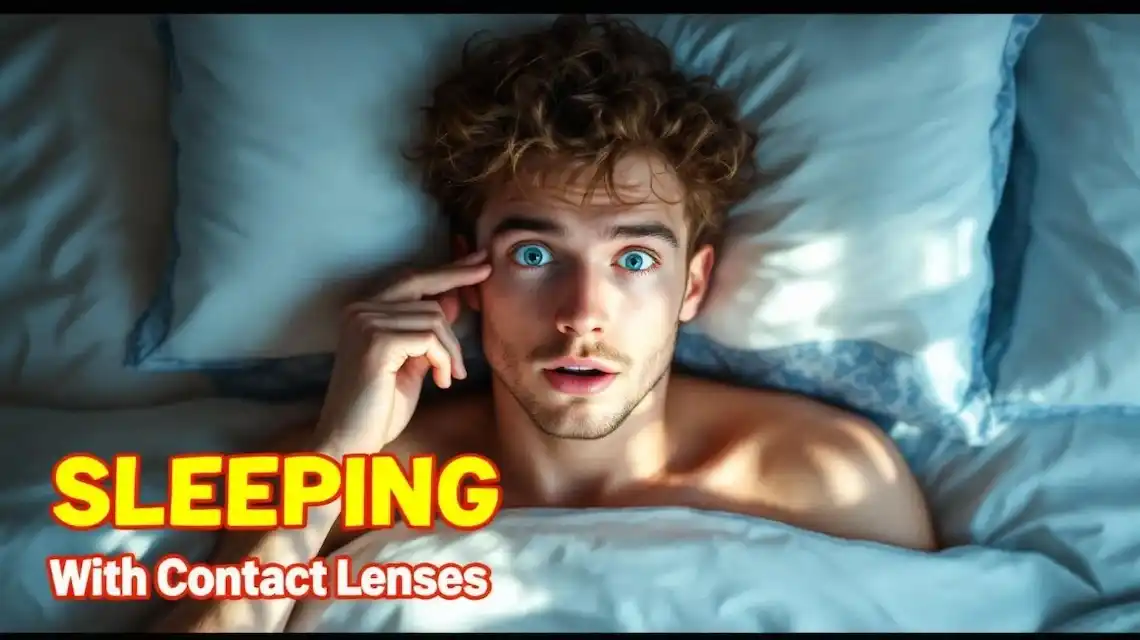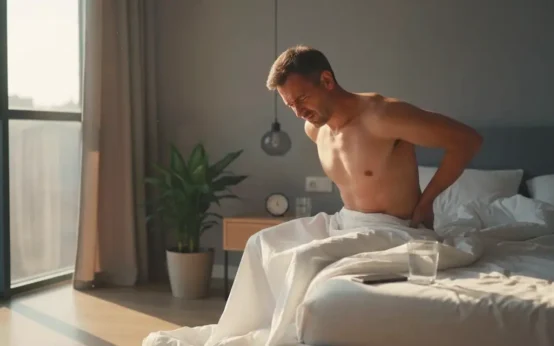Can we sleep with contact lenses? It sounds harmless, especially after a long day. The quick answer is usually no, and even when a doctor approves extended wear, the risk goes up.
This guide explains what really happens to your eyes when you sleep in contacts, why the risk climbs at night, what to do if it already happened, and safer habits for naps, flights, and late shifts. You will get clear steps, plain language, and useful checklists you can use today.
Your eyes work hard for you. With the right plan, you can keep convenience without risking your sight.
Can we sleep with contact lenses? The short answer and the real risk
Sleeping in contact lenses raises your chance of eye infection a lot, about 6 to 8 times higher than not sleeping in them. This heightened risk shows up in research and in everyday eye care. The risk applies to most lens types, including silicone hydrogel. These newer materials let in more oxygen, but not enough to make sleep risk free.
Let’s make the terms clear. A quick nap is still sleep. Overnight sleep is longer and usually drier for your eyes. Weeks of wear means you keep the same lenses in day and night. Some lenses are FDA approved for extended wear, which means they can be worn overnight for a certain number of nights, but only with a doctor’s guidance, regular checks, and a strict care routine.
Why do people do it anyway? Convenience. Falling asleep on the couch. Long travel days. Late shifts. That convenience often comes with a hidden tradeoff. Your corneas get less oxygen during sleep, the lens surface can collect germs, and skipping cleanings allows buildup to grow. Altogether, infection risk rises.
So what is the best move most nights? Take your contacts out before sleep. Keep a case and solution at your bedside. If you are not sure what your lens can handle, or you want to ask about extended wear, talk with your optometrist. When in doubt, use glasses. Your eyes will thank you.
Is any type of contact lens safe for sleep?
- Daily disposables: Never sleep in them. They are made for single use only.
- Monthly or two-week lenses: Do not sleep in them unless your exact brand is FDA approved for extended wear and your doctor says it is okay.
- Silicone hydrogel: They allow more oxygen, but risk still rises during sleep.
- Rigid gas permeable and orthokeratology (ortho-k): These are special cases, used under doctor care. Do not try to copy this on your own.
Why doctors still say no most nights
Real life gets messy. Long days, screen time, dry rooms, late nights, and missed cleanings all stack up. Dryness and lens buildup make sleep riskier, even for healthy eyes. Removing your lenses gives your corneas a break, boosts oxygen, and lowers infection risk. This is why most eye doctors still recommend taking them out before you doze.
Who has a higher risk of trouble
- Smokers
- People with dry eye, allergies, or a recent eye infection
- Anyone with diabetes or a weak immune system
- New contact lens wearers
- Poor hygiene or lenses exposed to water (shower, pool, hot tub)
If you fit one of these, avoid sleeping in contacts and talk to your doctor about safer options.
What happens to your eyes when you sleep in contacts
Your cornea needs oxygen to stay clear and healthy. During the day, it gets oxygen from the air. With your eyes closed and a lens on, oxygen drops. That drop can lead to swelling and small changes in the cornea’s surface. When this happens often, the chance of infection rises.
Germs also love a warm, moist surface. A contact lens can act like a tiny sponge. Overnight, bacteria and other tiny organisms can multiply on the lens and under it. If they get into the corneal surface, they can cause a sore called a corneal ulcer. This can leave a scar and harm your vision if not treated fast.
Common problems after sleeping in contacts include redness, pain, light sensitivity, blurry vision, and discharge. These signs can show up in the morning or later in the day. Do not ignore them. Short naps can trigger the same issues, just at a smaller scale.
If you notice sharp pain, new light sensitivity, worsening blur, or a white spot on your eye, stop wearing contacts and call an eye doctor right away.
Less oxygen, more swelling
Corneal hypoxia sounds complex, but it is simple. Your cornea needs air to stay clear. When you sleep, oxygen drops even more, and a lens lowers it further. This can cause swelling, discomfort, and blurry vision. Silicone hydrogel materials help, but they do not remove the risk.
Germs can grow while you sleep
Bacteria and tiny organisms stick to lenses during the day. Overnight, they have time to grow on the lens and the eye’s surface. This is how infections and corneal ulcers can start, especially if lenses are not cleaned well or are worn beyond their schedule.
Dryness, redness, and pain
A lens can trap debris and reduce tear flow. Sleeping dries out the eye more, so the lens can stick and rub the cornea. You wake up with burning, redness, and a gritty feeling. This can take hours to calm down, and it may repeat if you keep sleeping in lenses.
Warning signs you should not ignore
- Sharp or worsening pain
- Light hurts your eyes
- New discharge or crusting
- Sudden blur or haze
- A white or gray spot on the cornea
- Swelling around the eye
These can mean infection. Stop wearing contacts and call an eye doctor right away.
I slept in my contacts, what should I do now?
It happens. Do not panic. Take calm, safe steps to protect your eyes. Your goal is to loosen the lens, remove it without scraping the cornea, and watch for warning signs.
If pain is severe or your vision is getting worse, skip the home steps and call an eye doctor now. Eye infections can get serious fast.
First steps when you wake up
- Wash and dry your hands.
- Do not yank the lens out. Blink a few times and add sterile rewetting drops or preservative-free artificial tears.
- Wait a few minutes to let the lens loosen before removal.
How to remove a stuck contact safely
- If the lens will not move, add more lubricating drops and gently massage the eyelid.
- Look up, down, left, and right to shift the lens. Try again after 5 to 10 minutes.
- Do not use water or saliva. If it stays stuck or you feel pain, call an eye doctor.
Aftercare to calm your eyes
- Throw away a disposable lens after a sleep-in.
- Give your eyes a break from contacts for 24 to 48 hours if they feel irritated.
- Use preservative-free lubricating drops. Avoid redness-relief drops that only shrink blood vessels.
- Switch to glasses until your eyes feel normal.
When to call an eye doctor right away
- Seek care fast if you have severe pain, light sensitivity, new discharge, worsening blur, or a white spot on the eye.
- If symptoms do not improve in 24 hours, get checked. Infections can get worse quickly.
Safer choices if you nap, travel, or work late
Life does not pause for eye care, so build habits that make healthy choices easy. Keep a small kit. Have a backup plan for naps and long trips. Ask your doctor about lens options that fit your routine, and keep your cleaning routine tight.
Convenience should not cost your sight. A few small steps keep you safe even on the busiest days.
Make a nap plan you can follow
- Keep a small kit: glasses, lens case, travel-size multipurpose solution, and lubricating drops.
- Set a 20 to 30 minute timer for naps and remove lenses first. If you are too tired, switch to glasses before you rest.
Travel tips for planes, cars, and camps
- For flights, wear glasses if you might sleep. Cabin air is very dry.
- For road trips or camps, pack extra lenses, backup glasses, and single-use drops.
- Never clean lenses with water. Avoid hot tubs and pools while wearing contacts.
Lens options that are better for long days
- Daily disposables are the easiest for hygiene on busy days.
- If you need overnight wear, ask your eye doctor about lenses that are FDA approved for extended wear. Understand that risk is still higher than removing them.
- Consider ortho-k worn at night under doctor care, or glasses for late nights.
Clean and store your lenses the right way
- Wash and dry hands before handling lenses.
- Rub and rinse lenses with fresh solution every time. Do not top off old solution.
- Replace the case every 1 to 3 months. Let it air dry between uses.
- These steps cut risk if you ever accidentally sleep in lenses.
Conclusion
So, can we sleep with contact lenses? Usually no. Even with doctor-approved extended wear, the risk of infection and irritation is higher than taking them out.
Remember the basics: remove lenses before sleep, carry a simple kit, use glasses for naps and flights, and call your eye doctor if you feel pain or notice changes. Small daily habits protect your sight for the long run.
Book a quick checkup, ask about the safest plan for your routine, and keep your eyes happy and clear.
Related post. How to Sleep at Night With Tinnitus
FAQ:
Is it safe to sleep with contact lenses?
Usually no. Sleeping in contacts lowers oxygen to the cornea and raises the risk of infection, pain, and dryness. Even one night increases risk.
What if my lenses are approved for overnight wear?
Some silicone hydrogel lenses are FDA approved for extended wear. Risk still rises when you sleep in them. Many eye doctors suggest removing them nightly if possible.
Is a quick nap with contacts okay?
It still carries risk. Short naps can cause dryness, stuck lenses, and irritation. Remove them first if you can.
What should I do if I fell asleep in my contacts?
Do not pull them out dry. Add sterile rewetting drops, wait a few minutes, then remove gently. If the lens will not move, add more drops and try again later. If you have pain, redness, or light sensitivity, call your eye doctor.
What are the risks of sleeping in contacts?
Higher odds of corneal infection, corneal ulcers, red eye, and inflammation. You may have blurred vision, light sensitivity, discharge, and severe pain if infection develops.
How much does the infection risk increase?
Studies show a several-fold increase with overnight wear compared to daily wear. The exact risk varies by lens type, hygiene, and your eyes. Doctors treat any overnight wear as higher risk.
How long can I sleep in extended-wear contacts?
Follow your prescription only. Some brands allow up to 6 nights, some up to 30 days, but few people tolerate the maximum safely. Stop early if you feel any discomfort.
Who should not sleep in contacts at all?
People with dry eye, allergies, frequent eye infections, diabetes with poor control, smokers, or those who struggle with hygiene. If you work in dusty areas, it is also a bad idea.
What are signs I need urgent care after sleeping in contacts?
Severe pain, redness, discharge, sudden blurred vision, light sensitivity, or a white spot on the cornea. Remove the lens if you can, then seek urgent eye care the same day.
Can sleeping in contacts cause permanent damage?
Yes. Corneal ulcers and scarring can lead to lasting vision loss if not treated quickly.
Do daily disposables make sleeping in contacts safer?
They reduce deposits and allergy issues, but sleeping in any soft lens still raises infection risk. Daily disposables are for daytime wear, then discard.
Are rigid gas permeable (RGP) lenses safe to sleep in?
Standard RGPs are not for sleep. A special type, orthokeratology (ortho-k), is worn overnight to reshape the cornea, but only under a doctor’s care with strict hygiene.
How do I remove a contact stuck after sleep?
Wash and dry hands. Use sterile rewetting drops, blink, and wait a few minutes. Gently slide the lens before pinching it out. Never force it. Seek help if it remains stuck or painful.
Can I use water if my lens is dry?
No. Tap water can carry acanthamoeba, a serious organism that can cause vision loss. Use only sterile contact lens solution or rewetting drops.
Does sleeping in contacts cause dry eye?
It can trigger or worsen dryness. Oxygen drops during sleep, tears evaporate, and lenses can stick to the cornea, which irritates the surface.
Do blue light or UV-blocking contacts make sleeping safer?
No. These features do not change oxygen flow or infection risk.
What is the best practice for travel or red-eye flights?
Remove lenses before sleeping on planes. Carry a spare case, solution, and glasses. If removal is not possible, keep eyes lubricated, stay hydrated, and remove as soon as you can.
How should I clean lenses if I slept in them?
Remove them as soon as your eyes feel comfortable, then rub and rinse with fresh solution. Soak in clean solution for at least 6 hours. Never reuse old solution.
When should I replace my case and solution?
Rinse the case with solution daily, air dry face down, replace every 1 to 3 months. Use fresh solution each time. Never top off.
Can teens or new users sleep in contacts?
Not advised. New wearers tend to make more hygiene mistakes. Build good habits with daily removal first.
Are there safer alternatives to sleeping in contacts?
Yes. Wear glasses at night, use daily disposables for daytime, or ask about ortho-k if you need overnight vision correction under supervision.
What if I must sleep in lenses due to my schedule?
Discuss extended-wear options with your eye doctor. Use the lowest-risk lens, strict hygiene, regular checkups, and keep backup glasses. Remove lenses at the first sign of discomfort.




 Importance of Hydration for Your Brain, Body, and Everyday Energy
Importance of Hydration for Your Brain, Body, and Everyday Energy  Healthiest Breakfast Cereal for Children
Healthiest Breakfast Cereal for Children  Anxiety Management Techniques
Anxiety Management Techniques  Can a Mattress Make You Sore?
Can a Mattress Make You Sore?  What Makes Fat in Our Body?
What Makes Fat in Our Body?  Best Diet to Reduce Risk of Diabetes
Best Diet to Reduce Risk of Diabetes